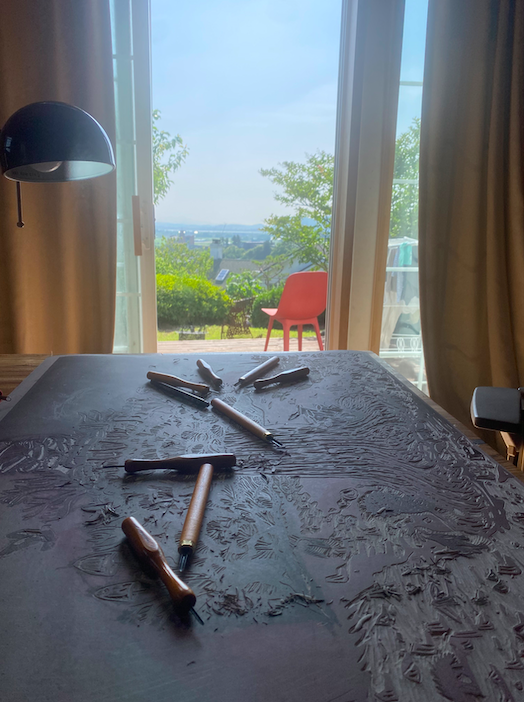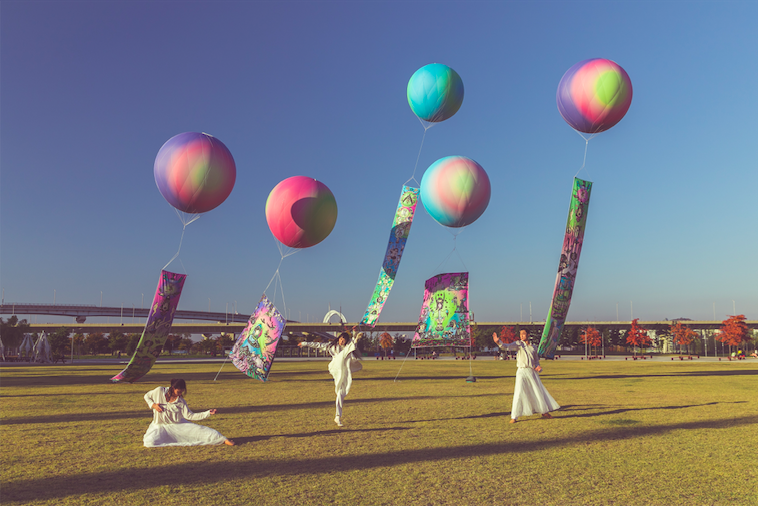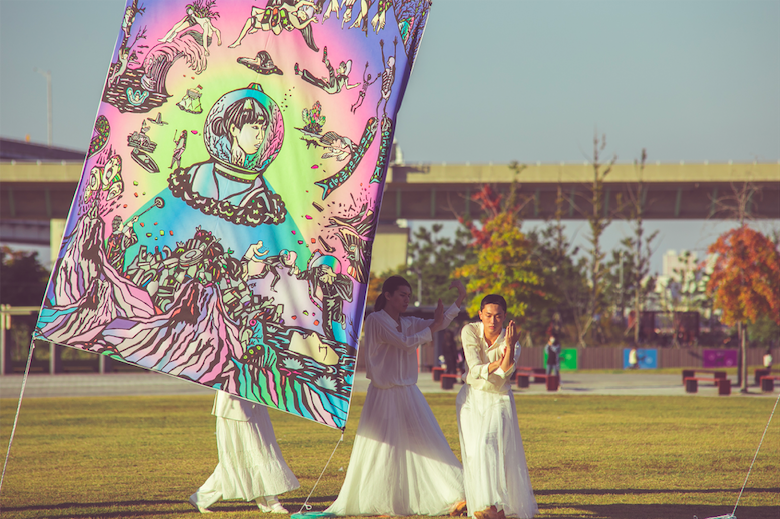by Lucile Chastre
(English version below)
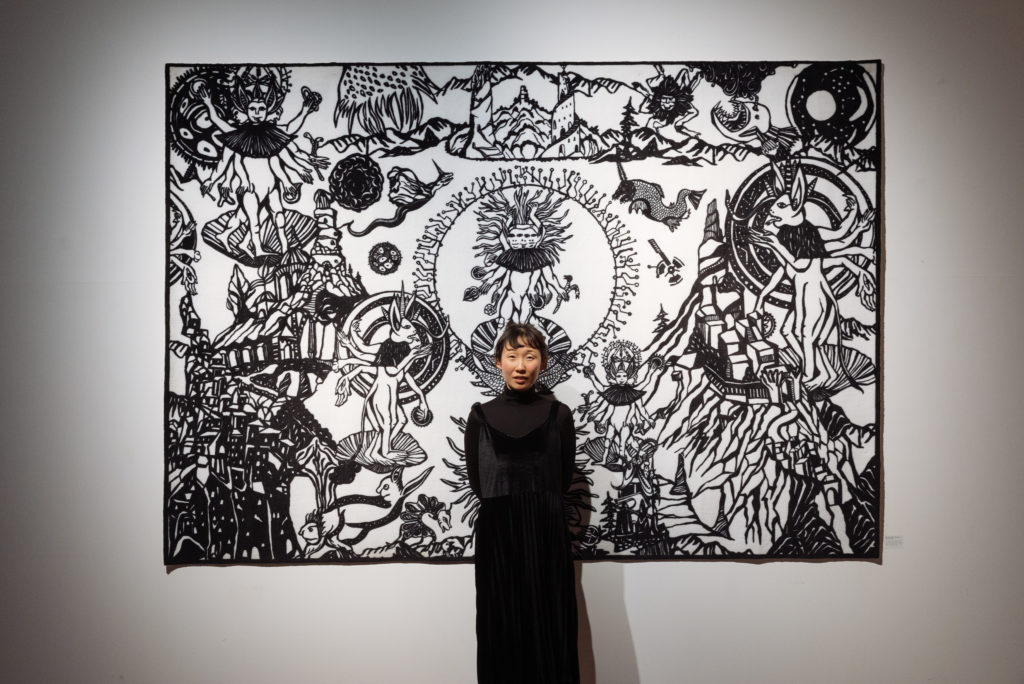
Voyage dans le monde de Lee Seungyoun
Lee Seungyoun est une artiste sud-coréenne sans frontière. Qualifiée par la critique d’art Cho Juri (1) de « Wanderer » (soit « promeneur » ou « voyageur »), elle explore le monde, les cultures humaines et les techniques de création avec liberté. Ses moyens d’expression, qui s’enracinent toujours dans le dessin et l’écriture, sont comme elle, sans limitation, expansifs et joyeux. Ses créations, peintures, sculptures, gravures, photos, installations, performances, livres et vidéos… témoignent d’une richesse culturelle aussi vaste que les territoires qu’elle arpente.
Elle et son mari, l’écrivain-voyageur Park Jun vivent au nord de Séoul, à Paju. La ville, qui regroupe un grand nombre de maisons d’édition et d’imprimeries, est considérée, en Corée du Sud, comme la cité du livre. Le couple y habite une maison moderne, qui s’ouvre sur un jardin, peuplé par les sculptures de Lee. La ville et le mont Simhak dessinent la toile de fond d’un paysage spectaculaire. Derrière les premiers sommets, la ligne de démarcation entre les deux Corées trace une zone démilitarisée, qui est probablement la plus surveillée et la plus minée au monde. Cette dangereuse proximité ne semble pas inquiéter ces deux amoureux d’horizons lointains.
Lee Seungyoun est née à Séoul en 1982. Son père, physicien, fait voyager la famille au gré des postes qu’il occupe en Australie puis à Daejeon, la capitale scientifique de la Corée. Choisissant la voie artistique, la jeune fille part étudier à Séoul puis à Londres. Elle termine son cursus, diplômée de Design à l’université de Hongik et d’Environnements narratifs à Central Saint-Martins. Grande-Bretagne, France, Portugal, Roumanie, Bosnie, Allemagne, Maroc, Malaisie, Taïwan, Mexique, Guatemala… comptent parmi les pays où elle a séjourné parfois pendant des mois. Il suffit de parcourir le sommaire de New World fantasia (2), la monographie que Combine Works Art Space, sa galerie, lui a consacrée, pour comprendre que chaque destination est une source d’inspirations et que chaque production s’articule autour d’un espace géographique et culturel dont elle s’est imprégnée : Shukran Sahara (Maroc), My Sea, My Grand Tour (Malaisie, Portugal), Each Balkan Rhapsody (les Balkans), Glass Bead Carpathia (Roumanie), Once in this place (Allemagne), Yellow Paper Burners (Taïwan), Dr. Gentle and Mr. Man (Royaume-Uni)…
Lee Seungyoun dispose d’un espace de création, au cœur de la maison. La table de travail s’étend au centre d’une pièce qui s’ouvre, par de larges fenêtres, sur le jardin et, par une bibliothèque bien garnie, sur un vaste champ de connaissances. Son atelier ressemble à un studiolo d’humaniste, un lieu de réflexion et d’élaboration, à la fois connecté au monde et enrichi de lectures. Parmi les livres et les documents de travail, quelques œuvres de Lee se sont fait une place. Chacune est un voyage.
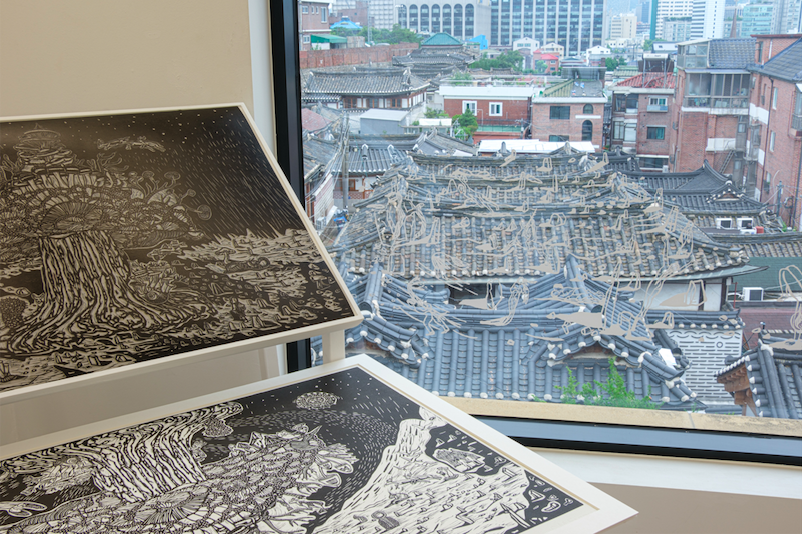
Dear My Forest
Une grande linogravure, tout juste terminée, repose sur la table. Au centre de la composition, sous un ciel constellé d’étoiles et de spores, se dresse un cèpe extraordinaire. Aussi majestueux qu’un grand chêne, il se ramifie en une myriade de champignons. Il abrite, sous son couvert, seize animaux, réels et fantastiques. Il s’agit de la dernière planche d’une série de seize gravures. Elles s’inscrivent dans un vaste cycle que Lee consacre à la forêt et qui comprend également des portraits de champignons en PVC, des lampes en bois recouvertes de feuille d’or, un programme digital créatif (3) et un livre d’images (4). En juillet 2024, Combine Works Art space expose des tirages sur papier des linogravures mais aussi quelques matrices (5). Avec ses multiples détails et nuances de reliefs, la plaque gravée mérite d’être traitée comme une œuvre à part entière.
Lee Seungyoun a eu l’idée du thème lors d’un séjour en plein cœur de la forêt finlandaise. Là-bas, au bout du monde, l’écosystème singulier de la taïga, la cueillette des champignons, le charivari des animaux nocturnes et du vent ont entraîné son imagination. Ses portraits de champignons empruntent au réel les caractéristiques des pleurotes, coprins, craterelles, bolets, mais d’une manière tellement amplifiée que chaque représentation devient fabuleuse. Ses images dégagent un charme surnaturel et une gravité écologique.
« La moitié de moi, qui s’épanouit comme une fleur, est dans le sol », raconte l’un des champignons. « Les forêts coulent tantôt dans le sol, tantôt dans le ciel », fait remarquer un autre. « La forêt est une rivière couchée, une rivière debout. » Par ses représentations et les récits qu’elle a imaginés, l’artiste franchit les barrières du visible : elle donne à voir le vaste monde souterrain de racines et de mycélium ; elle révèle des correspondances cachées entre les règnes du vivant. Dans l’ensemble de la série ‘Dear My Forest’, Lee Seungyoun réunit la science et la poésie, deux domaines souvent opposés. Il faut un regard attentif pour distinguer, au pied du grand cèpe, une silhouette humaine, qui se tient bien droit, sac sur le dos. Ne serait-ce pas un portrait de l’artiste en randonneuse, créature parmi les créatures, attentive au spectacle secret auquel la Nature l’a conviée ?
A New Paradise
A l’entrée du studiolo, une drôle de peinture est appuyée contre un mur : sans cadre, ni châssis, elle est montée sur une armature de cerf-volant. Une femme cosmonaute rayonne au centre. Autour d’elle, de multiples petites scènes représentent des hommes et des femmes dans diverses situations de détresse, tandis qu’un chevalier, venu des temps bibliques, sonne la trompette de l’apocalypse. La composition foisonnante, les visions baroques et les couleurs acidulées rappellent les peintures de Jérôme Bosch. D’ailleurs, une photo du panneau central de son célèbre Jardin des délices (vers 1510) trône sur le rebord de la fenêtre. On dirait que le peintre flamand, à l’imaginaire intarissable, veille sur Lee Seungyoun.
« Pendant l’épidémie de covid-19 », raconte-t-elle, « j’ai rêvé de grand air, d’évasion. Mais où aller, quand toutes les frontières étaient fermées ? Une seule voie était libre : le ciel ! » L’artiste, en mal de voyage, crée des peintures sur des supports aériens, bannières, cerfs-volants et ballons. Elle écrit aussi des chansons, car les paroles et la musique sont aussi libres que l’air :
« En voyant une luciole voler comme une brisure de lune, j’ai fait un rêve étrange.
Je veux briller comme une luciole.
Je veux rêver comme une luciole.
Je veux juste voler comme une luciole.[…]
Puissent ma peinture et la lune relier la terre au ciel,
Puissent ma chanson et la lune relier les hommes aux dieux,
Je l‘espère sincèrement. » (6)
Alors que l’humanité vit repliée, Lee sort ses œuvres au grand air pour une performance avec trois danseurs et un chanteur (7). Les peintures, lumineuses, diffusent entre ciel et terre leur message d’espoir, tandis que le chanteur Lee Heemoon égrène au vent les paroles du Nouveau paradis. Qu’elle se rêve en luciole et se représente en cosmonaute, Lee Seungyoun ne s’affirme-t-elle pas comme une messagère, investie d’une mission philanthropique : apporter aux humains du rêve, de la joie et de l’espoir ?
L’exubérance des motifs montre combien l’artiste a métissé les sources iconographiques. Les références au cinéma américain et à l’actualité se mêlent à des images iconiques de la peinture occidentale, religieuse et profane et à des représentations traditionnelles de la dynastie Joseon. Dans ces peintures de plein air comme dans les autres œuvres du cycle ‘New Paradise’, peintures digitales et sculptures acryliques, l’artiste nomade a opté pour un éclectisme sans frontière, affranchi des préjugés hiérarchiques entre beaux-arts et industrie culturelle.

The Shaman, Angel and Storyteller in 2100
Sur une étagère, adossée aux livres, se tient la sculpture d’une femme agenouillée, portant un diadème. Sa chevelure blanche est si longue, si ample qu’elle lui couvre le corps comme une pelisse sauvage. Les deux diadèmes monumentaux qui ont inspiré la coiffure de la figurine, reposent sur la bibliothèque. Le premier, avec ses deux têtes de dragons est la Couronne de l’ange, le deuxième, avec ses cornes, ses oreilles et son mufle de vache, la Couronne des nombres. Ces objets proviennent d’un cycle, ‘The Shaman, Angel and Storyteller in 2100’, que Lee Seungyoun a réalisé avec l’artiste britannique Alexander Augustus en 2015 et 2016.
Tous deux formaient un duo créatif, The Bite Back Movement, actif de 2012 à 2016. Ensemble, ils ont produit des cycles artistiques « provocateurs et inquiétants, mais aussi humoristiques et visuellement sensibles » (8) , qui éclairent certains phénomènes sociaux (croyances, migrations, travail…). Le cycle ‘The Shaman, Angel and Storyteller in 2100’ comprend 9 séries de sculptures, performances et vidéos qui portent toutes le nom d’une couronne, vecteur central du pouvoir chamanique. Inspirés par l’idée que le chamanisme redeviendra prépondérant en Corée, le duo a imaginé les rites et les costumes des chamanes du 22 e siècle. Les couronnes de l’ange et des nombres, en dentelle d’acier, semblent s’inscrire dans la tradition de l’orfèvrerie royale de Silla, un des âges d’or du chamanisme coréen. Les objets ont été rendus publics dans des installations exposées entre autres à la Tate Modern à Londres et au SeMA à Séoul et lors de performances réalisées avec la chamane Ham Suyeon et sa fille Kang Seung Yeon (9).
« C’est moi en chamane », explique Lee, tenant dans sa main la figurine aux longs cheveux, coiffée de la couronne de l’ange. La représentation de l’artiste en chamane n’a rien de surprenant, quand on sait qu’« à l’origine, le mot mudang (chaman) désigne une personne qui danse entre le ciel et la terre. Par la danse, il aide ceux qui souffrent ou qui sont dans la peine, et il comble le fossé entre les défunts et les vivants.» (10) Chamane, luciole, cosmonaute ou randonneuse, Lee Seugyoun s’attache à partager un art qui révèle, soigne, illumine et relie.
Ce bref voyage dans l’intimité de Lee Seungyoun révèle une artiste empreinte d’une spiritualité qui se réfère largement au christianisme et au chamanisme, une artiste qui voyage dans les mondes parallèles de l’imagination, de l’anticipation et des dieux, dans les entrailles de la terre et sur tous les continents du globe, dans les régions les plus reculées comme dans les mégalopoles. Ses sources d’inspiration sont elles aussi sans frontière, créant des images volontiers éclectiques. Si elle pratique le dessin, technique artistique la plus archaïque, c’est pour exploiter toutes les potentialités des logiciels de création comme des savoir-faire traditionnels, des nouveaux matériaux comme des matières naturelles. Ainsi ses dessins deviennent des sculptures et des masques d’acier, des dentelles de PVC et de bois, des peintures digitales et acryliques, des albums de papier et des programmes numériques créatifs… La liberté avec laquelle elle explore les techniques et les sujets est une des clefs de son talent.
« Je suis homme et rien de ce qui est humain ne m’est étranger » (11), écrivait le poète antique Terence. On croirait entendre Lee Seungyoun.
par Lucile Chastre, juin 2024
Notes
- In New world Fantasia – Seungyoun Lee, article « The Manuscripts – Under a Paradise Lost and Above a New Paradise » par Cho Juri, p. 11-17, Combine Works Art space, 2023, p.13.
- In New world Fantasia – Seungyoun Lee. Vous pouvez également consulter la chaîne YouTube de Lee Seungyoun : https://www.youtube.com/@SuperSeungyoun et son compte Instagram https://www.instagram.com/amazingseung/
- Rhapsody of the forest, Heart of the forest and Dance in the forest sont exposées jusqu’au 9 février 2025 au MMCA Gwacheon Children’s Museum in Seoul. https://dearmyforest.com/
- Dear My Forest (titre provisoire) à paraître en 2024 avec le soutien du MMCA.
- Beak of Forest, exposition à Combine Works Art space, Séoul, 2024.07.04 – 07.27.
- In New world Fantasia – Seungyoun Lee, p.39.
- La performance est visible sur Internet dans un film réalisé par Lee Seungyoun : https://youtu.be/SgLcpL5dzEs
- http://www.thebitebackmovement.com/ Page ‘About’.
- Certaines performances sont visibles dans des films réalisés par Lee Seungyoun et Alexander Augustus : https://www.youtube.com/watch?v=ywTttP-4VDU&ab_channel=SA (The Crown of Numbers) https://vimeo.com/228517541 (The Crown of Time and Space)
- New world Fantasia – Seungyoun Lee. « The crown of Angel », Lee Seungyoun, p. 154.
- Terence, Le Bourreau de Soi-même, 163 BC, citation du personnage Chrémès.

A Journey in the World of Lee Seungyoun
Lee Seungyoun is a South Korean artist who knows no boundaries. Described as a ‘wanderer’; by art critic Cho Juri (1), she freely explores the world, human cultures and creative techniques. Her means of expression are, like her personality, limitless, joyful and busting with life. Her creations – paintings, sculptures, engravings, photos, installations, performances, books and videos – bear witness to a cultural richness that is as vast as the territories she surveys.
Lee Seungyoun and her husband, travel writer Park Jun, live in Paju, around 30 km North of Seoul. Paju is unanimously recognized as the “book city” of Korea. It hosts a large number of publishing houses and book printing workshops. The couple lives there in a modern house, opening onto a garden, inhabited by Lee’s sculptures. The city skyline with Mount Simhak in the background provides a magnificent landscape. Just behind the hills passes the DMZ (demilitarized zone), the no-man’s land separating the two Koreas: the most heavily guarded and mined surface of land in the entire world. This dangerous proximity doesn’t seem to worry the two free space lovers and distant horizon addicts.
Lee Seungyoun was born in Seoul in 1982. Her father, a physicist, took the family to Australia and then to Daejeon, Korea’s capital of science. Choosing an artistic path, she studied in Seoul and then London. She graduated in Design from Hongik University and in Narrative Environments from Central Saint-Martins. Great Britain, France, Portugal, Romania, Bosnia, Germany, Morocco, Malaysia, Taiwan, Mexico and Guatemala are amongst the countries that she visited, not hesitating to spend months to better feel and understand some of the places. New World fantasia (2), the monograph that gallery Combine Works Art Space devoted to her work, shows how each destination is a source of inspiration, and how each of her production is based on the geographical and cultural space where she immersed herself: Shukran Sahara (Morocco), My Sea, My Grand Tour (Malaysia, Portugal), Each Balkan Rhapsody (Balkan Peninsula), Glass Bead Carpathia (Romania), Once in this place (Germany), Yellow Paper Burners (Taiwan), Dr. Gentle and Mr. Man (UK)…
Lee Seungyoun’s studio is located at the heart of her house. The work table stretches across the center of a room that opens, through large windows, onto the garden, and, through a well-stocked library, onto a vast field of knowledge. Connected to the outside world and enriched by the content of books, her creation space resembles a European Renaissance humanist’s studiolo, a room dedicated to study, meditation and elaboration. Among the books and documents, a few of Lee’s works have found their place. Each one may take you on a journey.

Dear My Forest
A large linocut rests on the table. At the center of the composition, under a sky studded with stars and spores, stands an extraordinary porcini mushroom. As majestic as a great oak, it branches out into a myriad of smaller mushrooms. Sixteen animals, both real and fantastic, stand out or hide in the composition. This is the last plate of a series of sixteen engravings. They are a part of a vaster work that Lee devoted to the forest, including PVC mushroom portraits, gold leaf covered wooden lamps, a creative digital program (3) and a picture book (4).
In July 2024, Combine Works Art Space will exhibit paper prints of the linocuts, as well as some of the matrices (5). With its multiple details and nuances of surface and relief, the engraved plate deserves to be treated as a work of art in its own right.
Lee Seungyoun got the idea of the series from a stay in the heart of the Finnish forest. Picking mushroom at the end of the human world, immersed in the unique ecosystem of the taiga, the feel of the wild wind and the hooting and hubbub of animals at night inflamed her imagination. Her mushroom portraits borrow from the characteristics of real oyster mushrooms, coprins, craterelles and boletes, but, in such an amplified way that they become fabulous. Her images exude supernatural charm and ecological gravity.
« Half of me, blooming like a flower, is in the ground »; says one mushroom. « Forests sometimes flow in the ground, sometimes in the sky »; adds another. « The forest is a river lying down, a river standing up »… The artist imagination crosses the barriers of the visible. She shows us the extended underground world of roots and mycelium. She reveals the hidden connections between living beings. In her series ‘Dear My Forest’, Lee Seungyoun brings together science and poetry, two fields that are often considered at odds with each other.
A tiny human figure stands at the foot of the marvelous giant mushroom. A creature among other creatures. Attentive to Mother Nature and her secret wonders. Perhaps a representation of the artist herself?
A New Paradise
A strange painting is leaning against a wall, mounted on a kite-like frame. Around the head of a female cosmonaut, multiple small scenes depict men and women in various situations of distress. A knight from biblical times sounds the trumpet of the apocalypse. The complex composition, baroque visions and bright colors recall the paintings of Hieronymus Bosch. In fact, a photo of the central panel of his famous ‘Garden of Earthly Delights’ (circa 1510) sits next to the window. The Dutch master, with his inexhaustible imagination, seems to be watching over Lee Seungyoun’s work.
« During the covid-19 pandemic » she tells, « I dreamed of outdoors, of getting away from it all. But where to go, when all borders were closed? There was only one clear path: the sky! » The artist was so desperate to travel, that she created paintings on aerial supports, banners, kites and balloons. She also wrote songs, because lyrics and music are as free as the air.
« Seeing a firefly like a fragment of a shattered moon, I have a bizarre dream.
I want to shine like a firefly.
I want to dream like a firefly.
I just want to fly like a firefly. […]
May my painting and the moon connect the earth and the sky,
May my song and the moon connect people and gods,
I sincerely hope. » (6)
At a time when mankind was living in isolation, Lee Seungyoun took her luminous paintings outside in the open for a performance with three dancers and one singer (7). A message of hope from heaven to earth. Lee Seungyoun imagines herself as a mediator, invested with a philanthropic mission: to bring dreams, joy and hope to human beings. In the detailed motifs of the paintings and acrylic sculptures of the series, the artist mixed various iconographic sources. Images taken from American movies and contemporary events mingle together with iconic Western painting and traditional representations from the Joseon dynasty. In the series ‘New Paradise’ Lee Seungyoun opts for a borderless eclecticism, free from any prejudice or hierarchy between fine arts and cultural industry.

The Shaman, Angel and Storyteller in 2100
On a shelf, leaning against the books, stands a sculpture of a kneeling woman wearing a kind of crown. Her white hair is so long and plentiful that it covers her entire body, like an ancient coat. On the bookcase sit two monumental tiaras that inspired her hairstyle. The first tiara, with its two dragon heads, is ‘The Crown of the Angel’. The second, with its horns, ears and cow’s nose, is ‘The Crown of Numbers’. These objects are from the series ‘The Shaman, Angel and Storyteller in 2100’, a collaborative work of Lee Seungyoun and British artist Alexander Augustus.
The two artists formed The Bite Back Movement, active from 2012 to 2016. They aimed at producing « provocative and uncanny, yet humorous and visually sensitive » works of art. (8) They shed light on social phenomena (beliefs, migration, work…). ‘The Shaman, Angel and Storyteller in 2100’ comprises 9 series of sculptures, performances and videos, all named after a crown, considered as the central vector of the shamanic power. Following the idea that shamanism could once again become dominant in Korea, the duo imagined the rites and costumes of potential 22nd-century shamans. ‘The Crown of the Angel and The Crown of Numbers’, made of steel lace, recall the tradition of the royal goldsmiths of Silla, one of the golden ages of Korean shamanism. The objects were made public in installations at the Tate Modern in London and the SeMA in Seoul, and in performances with real shaman, for example Ham Suyeon and her daughter Kang Seung Yeon. (9)
« This is me as a shaman »; explains Lee, holding the long-haired figure in her hand, wearing the angel’s crown. Her depiction as a shaman is hardly surprising. « Originally, the word mudang (shaman) describes a person who dances between heaven and earth. […] Through dance, they help those who are in pain or sorrow, and they bridge the gap between the deceased and the living ». (10)
Whether as shaman, firefly, cosmonaut or traveler, the artist Lee Seugyoun has the power to reveal, heal, illuminate and connect. Influenced by both Christianity and Korean ancestral spirituality, Lee Seungyoun’s work dances between the world of human and the world of nature, between the depth of the earth and the free space in the sky. Her sources of creation are boundless. She creates imaginative and eclectic images inspired by the remotest regions of the globe, as well as by its megacities. She utilizes drawing – maybe the oldest of all artistic techniques – and traditional skills and techniques, as well as she explores the infinite potential of digital programs and new materials. Doing so, her drawings may turn into steel sculptures, masks, PVC and wood lace, digital and acrylic paintings, paper albums and creative digital programs… The freedom with which she explores all the techniques and all the subjects is her trademark and the key to her unique talent.
Antic Roman poet Terence once wrote « I am a man, and I consider nothing that is human alien to me »(11). This declaration suits Lee Seungyoun perfectly.
by Lucile Chastre – June 2024
Notes
- In New world Fantasia – Seungyoun Lee, article « The Manuscripts – Under a Paradise Lost and Above a New Paradise » by Cho Juri, p. 11-17, Combine Works Art space, 2023, p.13.
- In New world Fantasia – Seungyoun Lee. See also : https://www.youtube.com/@SuperSeungyounhttps://www.instagram.com/amazingseung/
- Rhapsody of the forest, Heart of the forest and Dance in the forest are exhibited until 2025 the 9th of February at MMCA Gwacheon Children’s Museum in Seoul. https://dearmyforest.com/
- Dear My Forest (working title) is to be published in 2024 with the support of the MMCA.
- Beak of Forest, exhibition at Combine Works Art space, Seoul, 2024.07.04 – 07.27.
- In New world Fantasia – Seungyoun Lee, p.39.
- The performance can be seen on the Internet in a film directed by Lee Seungyoun : https://youtu.be/SgLcpL5dzEs
- http://www.thebitebackmovement.com/ Page ‘About’.
- Some performances can be seen in films directed by Lee Seungyoun and Alexander Augustus: https://www.youtube.com/watch?v=ywTttP-4VDU&ab_channel=SA (The Crown of Numbers) https://vimeo.com/228517541 (The Crown of Time and Space)
- New world Fantasia – Seungyoun Lee. « The crown of Angel », Lee Seungyoun, p. 154.
- Terence, The Self-Tormentor, 163 BC, citation from the part of character Chremes.
ACA project est une association française dédiée à la promotion de la connaissance de l’art contemporain asiatique, en particulier l’art contemporain chinois, coréen, japonais et d’Asie du sud-est. Grâce à notre réseau de bénévoles et de partenaires, nous publions régulièrement une newsletter, des actualités, des interviews, une base de données, et organisons des événements principalement en ligne et à Paris. Si vous aimez nos articles et nos actions, n’hésitez pas à nous soutenir par un don ou à nous écrire.
ACA project is a French association dedicated to the promotion of the knowledge about Asian contemporary art, in particular Chinese, Korea, Japanese and South-East Asian art. Thanks to our network of volunteers and partners, we publish a bimonthly newsletter, as well as news, interviews and database, and we organise or take part in events mostly online or in Paris, France. If you like our articles and our actions, feel free to support us by making a donation or writing to us.


